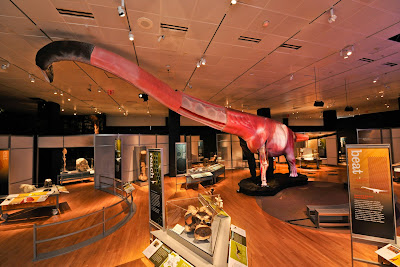Sunday, May 1, 2011
Think BIGGEST: World’s Largest Dinosaurs Exhibit at the American Museum of Natural History
The American Museum of Natural History just opened their exciting new show, The World’s Largest Dinosaurs, which will be on display through January 2, 2012. Guest blogger and AMNH employee Mindy Weisberger shares the inside story of this exhibit and these fascinating dinosaurs.
Giants in life and in children’s imaginations, sauropod dinosaurs are a source of awe and wonder. It’s been millions of years since the last Apatosaurus went extinct, yet sauropods still make regular appearances in mainstream media. And why not, when they’re naturally “larger than life”? These gargantuan four‐footed herbivores stood tall on legs that resembled tree trunks in height and girth. Their heads—and brains—were tiny, seemingly better suited to animals a fraction of their size. They sported necks and tails that were impossibly long and tethered to massive bodies, the skeletons of which dwarf the largest land animals alive today. Small wonder that these enormous dinosaurs are a perpetual subject of fascination for old and young alike. And now, sizable sauropods are the main attraction at the American Museum of Natural History’s newest exhibit, The World’s Largest Dinosaurs.
From the moment you step into a reconstructed Jurassic forest and meet the gaze of an Argentinosaurus peering down through the trees, you are face‐to‐face with sauropods as the living animals they once were. Sauropod biology is introduced and explained through a combination of traditional museum displays—dioramas and fossils—and media elements that engage you visually, intellectually, and physically. Unusual specimens, comparisons to living animals, and hands‐on activities all encourage even the youngest visitors to look at dinosaurs in a new way.
The biggest star of the exhibit is the 60‐foot model of a female Mamenchisaurus that occupies the center of the gallery. Projected on her flank is a video of her internal organs at work, while a paleontologist’s voiceover explains how she ate, breathed, digested her food and reproduced. All of these biological systems make up the “big picture” of sauropod gigantism; many physical features working together is what made it possible for sauropods to grow so big.
There are numerous interactives that help you become more closely acquainted with sauropod biology. An arcade‐style computer game lets you feed a sauropod while learning about their food intake and metabolism. You’ll have the opportunity to measure sauropod femurs and use your findings to calculate the animal’s weight.
Animations guide you in a pumping exercise to understand how difficult it was for a sauropod’s heart to circulate blood around its massive body. A spinning zoetrope depicts sauropod locomotion, bringing tiny 3D models of a sauropod family to life in a stop‐motion walk cycle. A glance through 3D viewers reveals different colors and patterns that sauropods may have sported. And you can channel your inner paleontologist by excavating sauropod bones in a sandy dig pit, while a nearby video introduces several of the scientists who contributed to the exhibit.
The World’s Largest Dinosaurs certainly brings the “Wow!” but it wouldn’t be a science exhibit if it didn’t address the “How?” How fast did sauropods grow? How could they eat enough to survive? How did they raise their young? And HOW did they get so big? These questions and many more about the biology of these amazing animals are asked and answered; visitors will find insights aplenty as they “dig in” to the subject of sauropods, and uncover the smallest details in the big picture of these giants from the past. — Mindy Weisberger
The World’s Largest Dinosaurs is on view at the American Museum of Natural History through January 2, 2012. To learn more about the exhibit, visit the museum’s website: http://www.amnh.org/exhibitions/wld/
Mamenchisaurus
This 11-foot-tall, 60-foot-long model of a Mamenchisaurus is the centerpiece of the exhibition. Approximately the size of a tractor-trailer, the life-sized, fleshed-out model of a young adult female Mamenchisaurus, distinguished by its remarkable 30-foot neck, features skin texture on one side and video projections on the other side that provide a look inside the dinosaur’s body.
© AMNH/D. Finnin
Free-standing Food Cube
A 5½-foot cube of foliage on display represents how much plant matter—approximately 1,000 pounds—a Mamenchisaurus ate in a single day. To survive, a Mamenchisaurus needed 100,000 calories a day, which it got from a leafy diet of horsetail, ginkgo, conifers, and ferns. In contrast, the average adult human male needs just 2,200 calories per day.
© AMNH/D. Finnin
Measure a Femur
In this interactive exhibit, visitors can estimate the body weight of two different sauropods by measuring the length of their thigh bones.
© AMNH/D. Finnin
Dig Pit
This dig pit inspired by Howe Quarry in Wyoming—an excavation site where over 4,000 sauropod fossils have been found—allows visitors to unearth and examine “fossils.” Measuring 11-by-15-foot, the fully-interactive dig pit features sauropod femurs, ribs, skulls, and more.
© AMNH/D. Finnin
Mamenchisaurus Heart Model
A Mamenchisaurus heart moved an estimated total of about 635 quarts of blood through its body, compared to the 7 quarts circulated by the human heart.
©AMNH/D. Finnin
PLEASE NOTE: These images are supplied free solely for one-time use by print, broadcast, and online media for publicity purposes related to the exhibition The World’s Largest Dinosaurs. No other use of these images is permitted without the express written permission of the Museum and/or the owners of the images.
Subscribe to:
Post Comments (Atom)







yes
ReplyDeleteThis comment has been removed by a blog administrator.
ReplyDelete